ASRock Industrial NUC BOX-1360P/D5 Review: Raptor Lake-P on the Leading Edge
by Ganesh T S on July 18, 2023 10:30 AM EST- Posted in
- Systems
- Intel
- UCFF
- Mini-PC
- ASRock Industrial
- Raptor Lake-P
Workstation Performance - SPECworkstation 3.1
SFF PCs traditionally do not lend themselves to workstation duties. However, a recent trend towards miniaturized workstations has been observed. While UCFF systems are still not capable enough to become workstations, the rapid performance improvements over the years has encouraged us to benchmark some of the systems for both content creation workloads as well as professional applications. Towards this, we processed the SPECworkstation 3.1 benchmark from SPEC.
The SPECworkstation 3.1 benchmark measures workstation performance based on a number of professional applications. It includes more than 140 tests based on 30 different workloads that exercise the CPU, graphics, I/O and memory hierarchy. These workloads fall into different categories.
- Media and Entertainment (3D animation, rendering)
- Product Development (CAD/CAM/CAE)
- Life Sciences (medical, molecular)
- Financial Services
- Energy (oil and gas)
- General Operations
- GPU Compute
Individual scores are generated for each test and a composite score for each category is calculated based on a reference machine (HP Z240 tower workstation using an Intel E3-1240 v5 CPU, an AMD Radeon Pro WX3100 GPU, 16GB of DDR4-2133, and a SanDisk 512GB SSD). Official benchmark results generated automatically by the benchmark itself are linked in the table below for the systems being compared.
| SPECworkstation 3.1 Official Results (2K) | |
| ASRock NUC BOX-1360P-D5 (Performance) | Run Summary |
| ASRock NUC BOX-1360P-D5 (Normal) | Run Summary |
| ASRock 4X4 BOX-7735U (Performance) | Run Summary |
| ASRock 4X4 BOX-7735U (Normal) | Run Summary |
| Intel NUC13ANKi7 (Arena Canyon) | Run Summary |
| ASRock NUC BOX-1260P | Run Summary |
| ASRock 4X4 BOX-5800U (Performance) | Run Summary |
| ASRock NUCS BOX-1360P-D4 | Run Summary |
| Intel NUC12WSKi7 (Wall Street Canyon) | Run Summary |
Details of the tests in each category, as well as an overall comparison of the systems on a per-category basis are presented below.
Media and Entertainment
The Media and Entertainment category comprises of workloads from five distinct applications:
- The Blender workload measures system performance for content creation using the open-source Blender application. Tests include rendering of scenes of varying complexity using the OpenGL and ray-tracing renderers.
- The Handbrake workload uses the open-source Handbrake application to transcode a 4K H.264 file into a H.265 file at 4K and 2K resolutions using the CPU capabilities alone.
- The LuxRender workload benchmarks the LuxCore physically based renderer using LuxMark.
- The Maya workload uses the SPECviewperf 13 maya-05 viewset to replay traces generated using the Autodesk Maya 2017 application for 3D animation.
- The 3ds Max workload uses the SPECviewperf 13 3dsmax-06 viewset to replay traces generated by Autodesk's 3ds Max 2016 using the default Nitrous DX11 driver. The workload represents system usage for 3D modeling tasks.
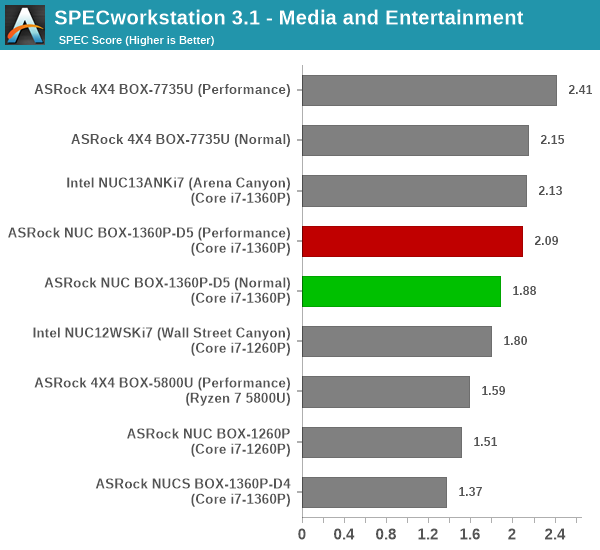
Product Development
The Product Development category comprises of eight distinct workloads:
- The Rodinia (CFD) workload benchmarks a computational fluid dynamics (CFD) algorithm.
- The WPCcfd workload benchmarks another CFD algorithm involving combustion and turbulence modeling.
- The CalculiX workload uses the Calculix finite-element analysis program to model a jet engine turbine's internal temperature.
- The Catia workload uses the catia-05 viewset from SPECviewperf 13 to replay traces generated by Dassault Systemes' CATIA V6 R2012 3D CAD application.
- The Creo workload uses the creo-02 viewset from SPECviewperf 13 to replay traces generated by PTC's Creo, a 3D CAD application.
- The NX workload uses the snx-03 viewset from SPECviewperf 13 to replay traces generated by the Siemens PLM NX 8.0 CAD/CAM/CAE application.
- The Solidworks workload uses the sw-04 viewset from SPECviewperf 13 to replay traces generated by Dassault Systemes' SolidWorks 2013 SP1 CAD/CAE application.
- The Showcase workload uses the showcase-02 viewset from SPECviewperf 13 to replay traces from Autodesk's Showcase 2013 3D visualization and presentation application
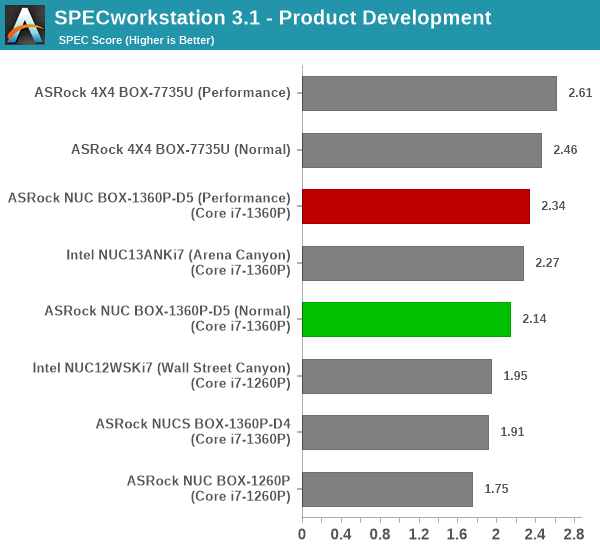
Life Sciences
The Life Sciences category comprises of four distinct test sets:
- The LAMMPS set comprises of five tests simulating different molecular properties using the LAMMPS molecular dynamics simulator.
- The NAMD set comprises of three tests simulating different molecular interactions.
- The Rodinia (Life Sciences) set comprises of four tests - the Heartwall medical imaging algorithm, the Lavamd algorithm for calculation of particle potential and relocation in a 3D space due to mutual forces, the Hotspot algorithm to estimate processor temperature with thermal simulations, and the SRAD anisotropic diffusion algorithm for denoising.
- The Medical workload uses the medical-02 viewset from SPECviewperf 13 to determine system performance for the Tuvok rendering core in the ImageVis3D volume visualization program.
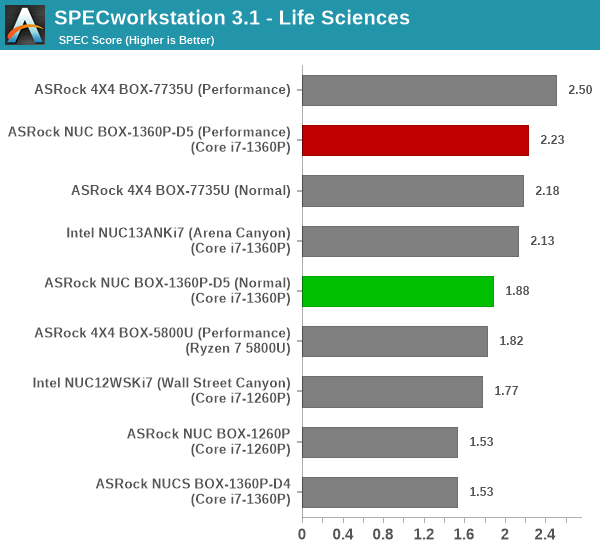
Financial Services
The Financial Services workload set benchmarks the system for three popular algorithms used in the financial services industry - the Monte Carlo probability simulation for risk assessment and forecast modeling, the Black-Scholes pricing model, and the Binomial Options pricing model.
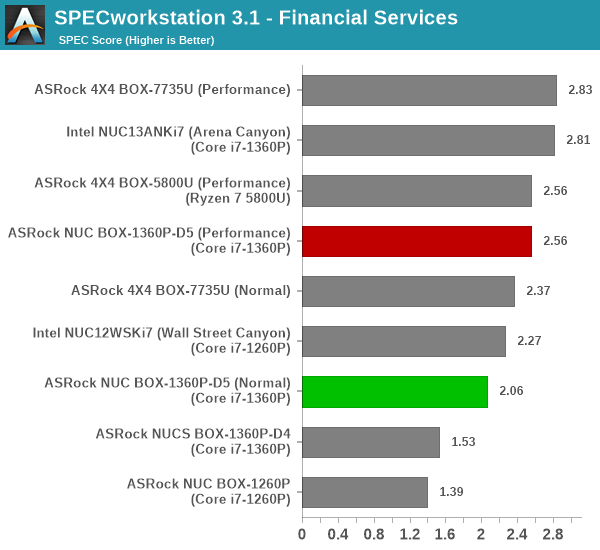
Energy
The Energy category comprises of workloads simulating various algorithms used in the oil and gas industry:
- The FFTW workload computes discrete Fourier transforms of large matrices.
- The Convolution workload computes the convolution of a random 100x100 filter on a 400 megapixel image.
- The SRMP workload processes the Surface-Related Multiples Prediction algorithm used in seismic data processing.
- The Kirchhoff Migration workload processes an algorithm to calculate the back propogation of a seismic wavefield.
- The Poisson workload takes advantage of the OpenMP multi-processing framework to solve the Poisson's equation.
- The Energy workload uses the energy-02 viewset from SPECviewperf 13 to determine system performance for the open-source OPendTec seismic visualization application.
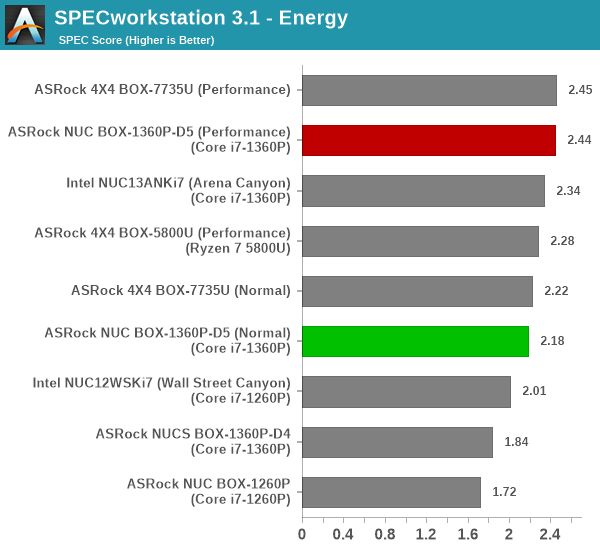
General Operations
In the General Options category, the focus is on workloads from widely used applications in the workstation market:
- The 7zip workload represents compression and decompression operations using the open-source 7zip file archiver program.
- The Python workload benchmarks math operations using the numpy and scipy libraries along with other Python features.
- The Octave workload performs math operations using the Octave programming language used in scientific computing.
- The Storage workload evaluates the performance of the underlying storage device using transaction traces from multiple workstation applications.
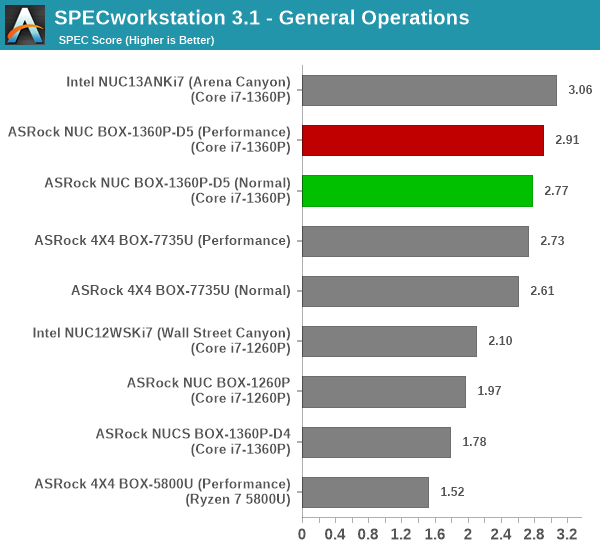
GPU Compute
In the GPU Compute category, the focus is on workloads taking advantage of the GPU compute capabilities using either OpenCL or CUDA, as applicable:
- The LuxRender benchmark is the same as the one seen in the media and entertainment category.
- The Caffe benchmark measures the performance of the Caffe deep-learning framework.
- The Folding@Home benchmark measures the performance of the system for distributed computing workloads focused on tasks such as protein folding and drug design.
We only process the OpenCL variants of the benchmark, as the CUDA version doesn't process correctly with default driver installs.

Overall, a large number of high-performance cores help the 4X4 BOX-7735U come out on top across almost all of the workload categories. Since these workloads demand sustained performance, the PL1 / PL2 tricks are not of much use. On the GPU compute side, Intel's iGPU fails on the caffe workload, causing the Intel-based mini-PCs to return abysmal scores for the component.










21 Comments
View All Comments
ganeshts - Wednesday, July 19, 2023 - link
Any links to such a 'NUC' ?I do have a Phoenix-based GTR7 from Beelink here in my testbed, but driver issues are preventing it from completing our benchmark suite. I am waiting for a new driver release from AMD.
lemurbutton - Friday, July 21, 2023 - link
And any M2 Mac Mini would destroy any Zen4 NUC.TheinsanegamerN - Monday, July 24, 2023 - link
Until you have to run something not in the MAC ecosystem. OOPS!PeachNCream - Friday, July 21, 2023 - link
I don't think destruction is quite the right to articulate your apparent thoughts. Perhaps "result in higher scores on benchmarks" or maybe "complete compute workloads sooner" would fit better in this case. Computer nerds appear to be rather detached from reality when expressing thoughts which gives all of them a bad reputation among the better positioned and more intelligent normal population.Samus - Saturday, July 22, 2023 - link
The problem with AMD enterprise and industrial products has always been management adoption. Intel has IT depts hooked on vPro, iME, AMT, etc.nicolaim - Wednesday, July 19, 2023 - link
It's 2023. Only two USB-C ports, none on the back.Samus - Thursday, July 20, 2023 - link
That was my gripe. Replace the HDMI and DP ports with two TB4-compliant USB-C ports on the rear would be the minimum modification for such an 'industrial' appliance. Seriously, why do you have to plug something into the front to use Thunderbolt?PeachNCream - Thursday, July 20, 2023 - link
Probably because nobody uses or cares about Thunderbolt. Sure it has that usual small, insane rabid fanbase that any obscure computer standard had in the past, but outside of the inevitable idiots that inflate its utility, no one cares and no one profits from it.abufrejoval - Monday, July 24, 2023 - link
That's a bit harsh.Yes, using TB to its full potential is somewhat expensive but given a choice, I'll always opt for the TB variant over pure USB, if only for 10Gbit Ethernet.
Front vs. back: I guess they have done their studies on how people use TB and unfortunately habits vary between people.
Most of my dual TB systems have one TB in the front, the other in the back and that works pretty well for me. The 10GBase-T NIC goes into the back port and the front port is open to anything transient, which could be just some USB media (these native SATA 10Gbit USB sticks are hard to beat via anything native TB), a temporary display (Alt-DP handy there) and in theory to things like TB networking, which is typically transient.
The older systems just have a single TB and expect a hub connected on the back, which seems sensible.
Two in the front and two in the back would be better still, even if you couldn't use all four at full speed for lack of PCIe lanes or a cheap enough switch.
Yet again, when your NUC is stuck to the back of a display, who cares what's front or back, because it's all behind the screen anyway and it's only people like me, wo use clusters of these NUCs as µ-servers in a "tiny-rack" who get bothered by the orientation of those ports.
Changing port orientation in a NUC means a mainboard redesign and few would want to pay for that. So I guess their asked their volume customers and this is what those came up with.
Very few vendors want to aggravate the customers.
sjkpublic@gmail.com - Thursday, July 20, 2023 - link
Performance comparison says it all. 1360P DOA. 7735U $100-200 cheaper for ASROCK. Even cheaper if you look at other companies.